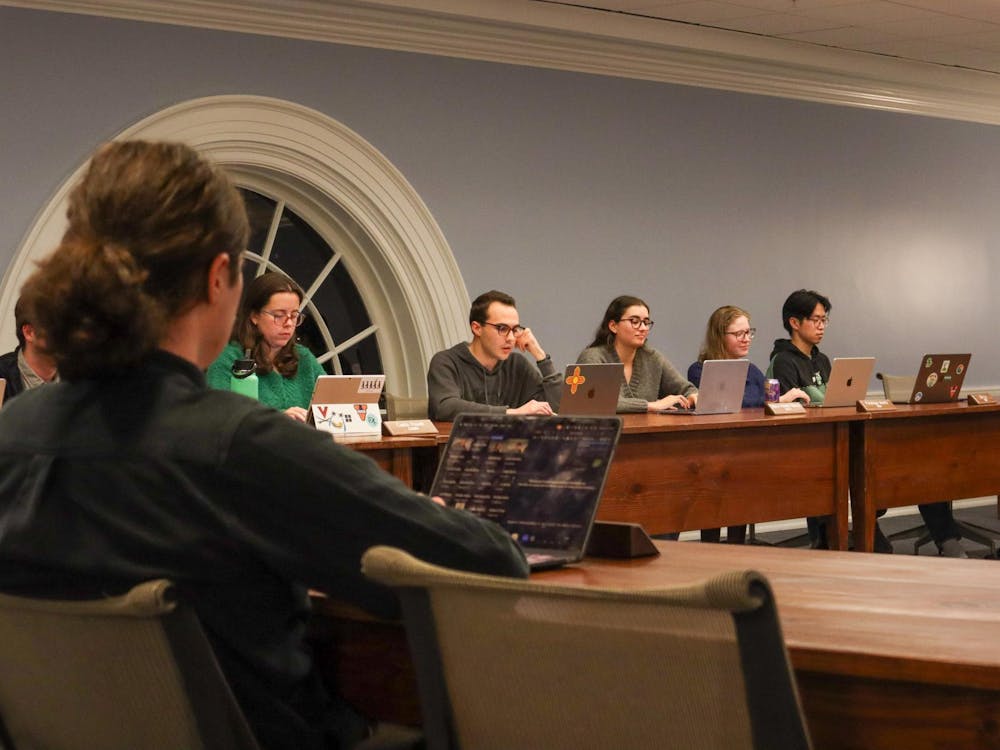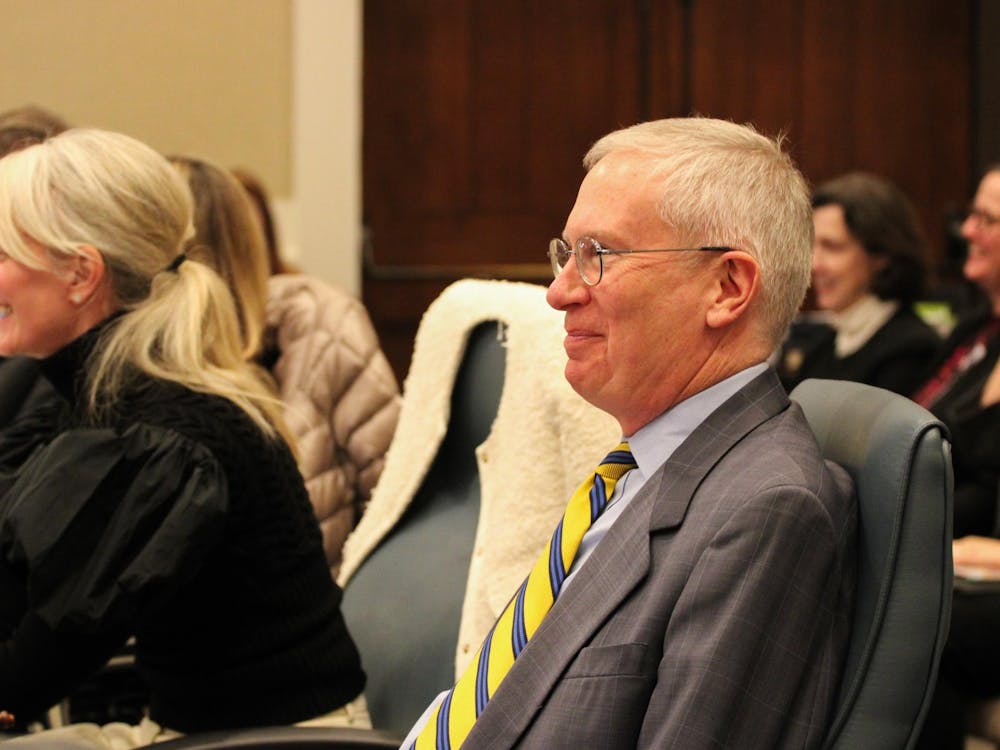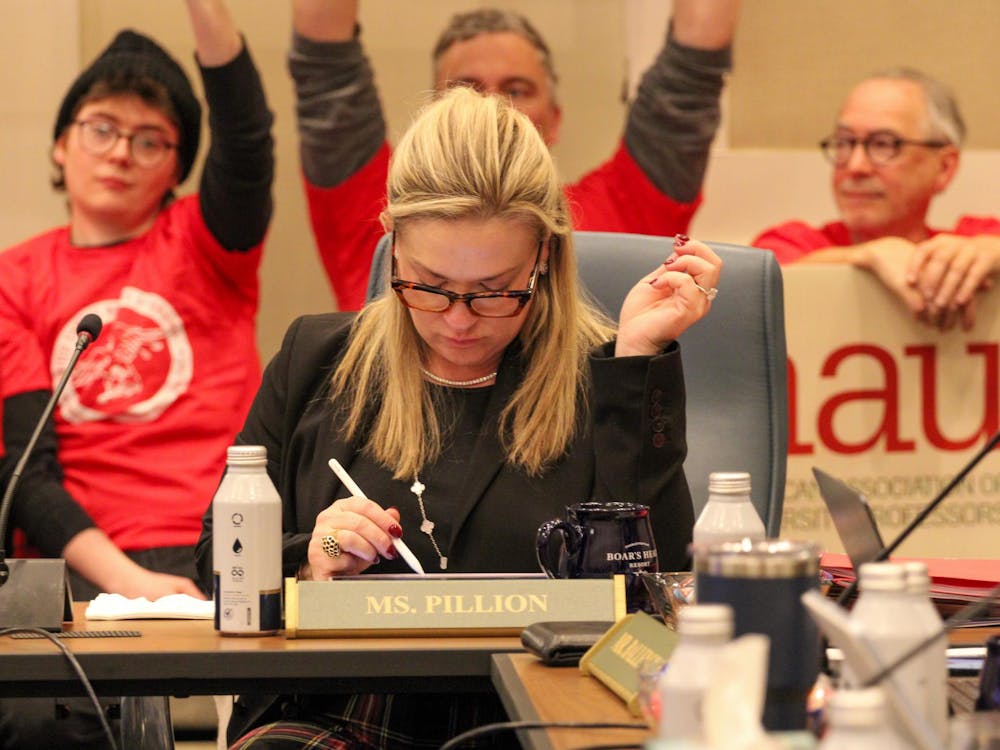awn acceptance letters were sent out Feb. 10 -- the 2006-2007 Lawn class has been chosen. Two hundred eighty-four rising fourth-years applied for 47 coveted non-endowed Lawn rooms.
Every year, a new selecting committee sifts through the hundreds of applications and chooses the following academic year's Lawn residents. With the exception of the seven endowed Lawn rooms, all Lawn residents are chosen through the main selection process.
The Process
The Lawn selection process is a two-phase process. The process of choosing the class is under two different committees, the Lawn Organizing Committee and the Selection Committee.
Applications first go to the Lawn Organizing Committee, which is composed of student representatives from mostly elected positions plus the head resident of the Lawn. Dean of Students Penny Rue heads the Lawn Organizing Committee, and Housing Director John Evans sits on this committee as well.
The Lawn Organizing Committee establishes a selection process for the Lawn each year by determining any criteria for selection, writing the application and establishing a timeline, according to Pat Lampkin, vice president for student affairs, who informally oversees the process.
"They basically establish the process and then they determine who is part of the selection process," Lampkin said.
After an initial discussion by the Lawn Organization Committee, which does not read the applications, the applications are reviewed by the student-run Selection Committee. There is significant overlap between the memberships of the two committees, Lampkin said.
One thing that never changes about the process is that students select students to live on the Lawn.
"It is a total student group," Lampkin said of the Selection Committee. "Then it's totally peer-selected, peer-driven."
The Lawn Selection Committee consists of 20 ex-officio members from elected positions in student organizations, said Jenni Allen, Lawn head resident and chair of the Selection Committee.
"We tried to get a broad representation of the student body," Allen said.
Allen, who is a non-voting member of the Selection Committee, said the group is very diverse and makes a point to include representatives of various facets of the University community -- for instance, the committee includes at least one transfer student.
In addition to the 20 ex-officio members, 15 members are selected by lottery. All 35 members of the Selection Committee are fourth-year undergraduates.
Allen said that even though there is no way to perfectly represent the whole student body in assembling a group, she was satisfied with the Selection Committee.
"I was pleased with representation on the committee," Allen said. "There were a variety of different opinions and we've successfully incorporated every member of the third-year class."
After each annual selection cycle, the committee reviews and revises its procedures for the next year, Lampkin said.
Two years ago, administrators and students gave the process a particularly significant makeover.
"A couple of years ago we made sure we had the right groupings, because the University culture changes," Lampkin said.
The changes included adding ex-officio positions to the Selection Committee.
This Year's Application
Rising-fourth years applied online in January and received the results in Feb. 10, according to Student Council president-elect and future Lawn resident Darius Nabors.
Allen said this year's application consisted of four essay questions.
"The first question was a laundry list explanation of peoples' activities," Allen said.
She said the Selection Committee received a variety of different responses to the second question, which asked about the applicants' contributions to the University.
The third question, which asked applicants to explain how the Lawn would aid them in achieving their fourth-year goals for contributing to the University, also provoked a variety of responses, according to Allen.
Allen said one of her contributions to this year's application was the fourth question on the 2006-2007 Lawn Application: "To be selected as a member of the Lawn Community is not merely an honor but a responsibility. In this context, how do you interpret responsibility?"
Allen said this question was included because of how treatment of the Lawn has changed over the years.
According to Allen, faculty members who have lived on the Pavilion "have noted that there has been a change in respect for the Lawn as a historic space," Allen said. "We added that question to see how students view responsibility of Lawn."
Allen said she hoped this element of this year's application will remain part of the process in the future.
Glitches in the System
Although both Lampkin and Allen said this year's Lawn selection was a fair process, Allen said she can't deny that there were problems.
Allen said some problems happened in part because this was the first year that the Lawn Selection process was completely over the Internet.
"One of the things that inevitably happened was that people waited until the last minute to submit applications," she said. "Because it was a totally electronic system, the computer shut off at 5 p.m. on a Friday. If you didn't get your application at exactly 5:00:00, [students] got turned away."
Allen also said that people had standard computer problems that complicated the application process.
By the Numbers
According to Jessica Humphreys, director of data management for the University Housing Division, the mean overall GPA for all Lawn applicants this year was 3.449. The median for all applicants was 3.520, and the standard deviation was 0.360.
The accepted students, overall, had higher grade point averages than that of that of the entire applicant pool. According to Humphreys, the mean overall GPA of the accepted students is 3.601, the median is 3.686, and the standard deviation is 0.324.
Variety or Over-representation?
There is no cookie-cutter profile of a member of the upcoming year's Lawn class, according to the applicants.
"Everyone on the Lawn is involved in a lot of different organizations," Nabors said.
Third-year Tom Holman, who applied and was accepted to be head resident of the Lawn in a separate process, said that the Selection Committee didn't appear to have a bias in selecting next year's Lawn residents.
"To me it seemed like the people accepted to live on the lawn were of a wide variety of interests and activities," Holman said.
The top five activities and organizations represented among next year's accepted Lawn class are Madison House, a fraternity or sorority, Student Council or class council, the University Guide Service and Honor Committee, according to Housing.
The acceptance rate of students in some activities was proportional to the amount that applied.
For instance, students on resident staff made up 13 percent of the total of both students applied and students accepted. School council members constituted eight percent of both applicants and accepted students, and the members of the Jefferson Literary and Debating Society constituted six percent of both pools.
On the other hand, while University Guide Service members made up 10 percent of the Lawn applicant pool, members account for 23 percent of accepted students. Other groups with a larger percentage of members in the acceptance pool than in the overall applicant pool include The Cavalier Daily and the Honor Committee.
Allen said there is no weighting system for organizations.
"There is no preordained system of ranking of particular activities," Allen said. "Applications are weighed in total, and we don't privilege any one organization."
She said she recognizes why applicants would think that some clubs seem more "valuable" in the selection process than others.
"Everyone is aware of the bias [that some organizations are more visible than others], which is what our committee discussed prior to applications," Allen said. "It's easy for applicants to forget that we know what they are thinking."
Five of the University's six undergraduate schools are represented among the 47 students in the originally accepted 2006-2007 Lawn class. Among these 47 are 39 students from the College, three from the Commerce School, one from the Nursing School, one from the Architecture School and four from the Engineering School. There were no students accepted from the Curry School of Education.
According to the statistics provided by Humphreys, there are 69 majors represented among the 47 accepted students. The most common majors of the accepted 2006-2007 Lawn class are American Studies, Economics and Political and Social Thought.
Too Many Students, Too Few Rooms
Students and administrators alike said there are too many qualified students to fit on the Lawn.
Lampkin said there are hundreds of students qualified to live on the Lawn every year.
Nabors said he noticed the high caliber of this year's applicants as well.
"The biggest thing is that everyone that applies is qualified," Nabors said. "But, it's a combination of being qualified and getting lucky."
Nabors said applying to live on the Lawn next year was a humbling experience.
"One of the interesting things about applying for the Lawn is that either way it happens, you're in a really great crowd of people because everyone is doing great things for the University."
Allen said the quality of the students and applications made the selection process difficult.
"I could create two Lawns over from the applicants who weren't selected and still have a fantastic community," Allen said.






